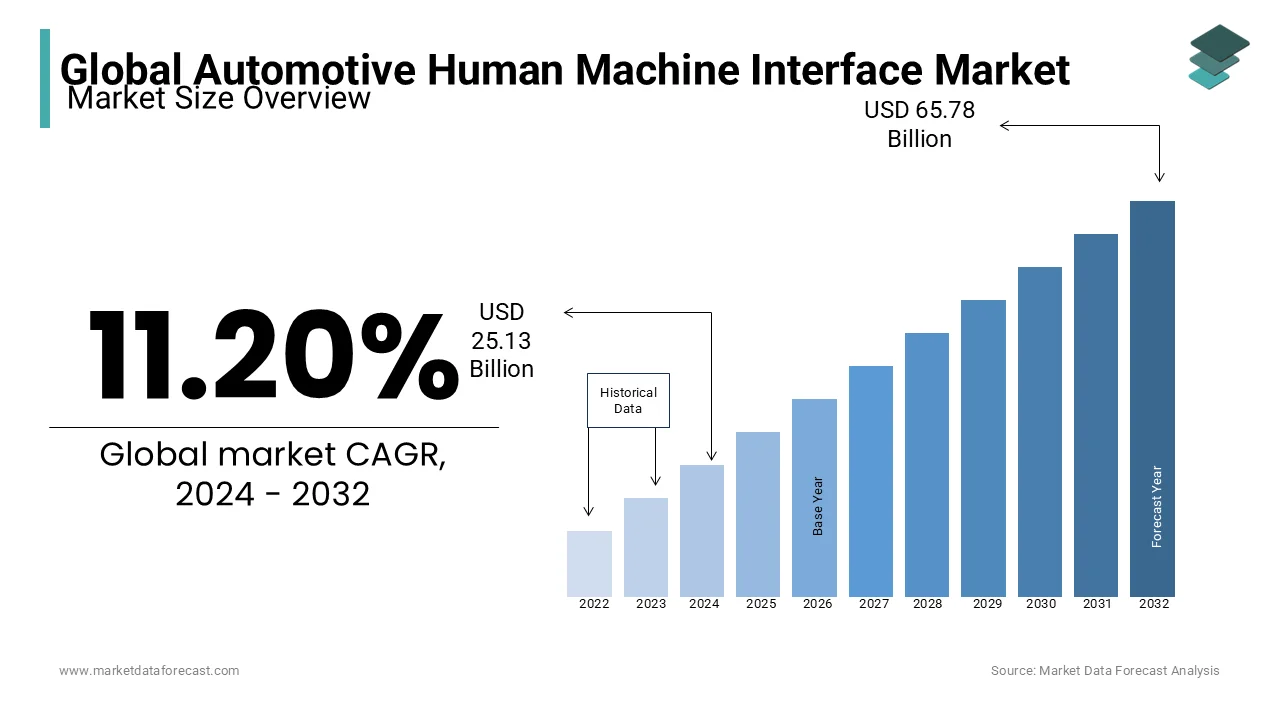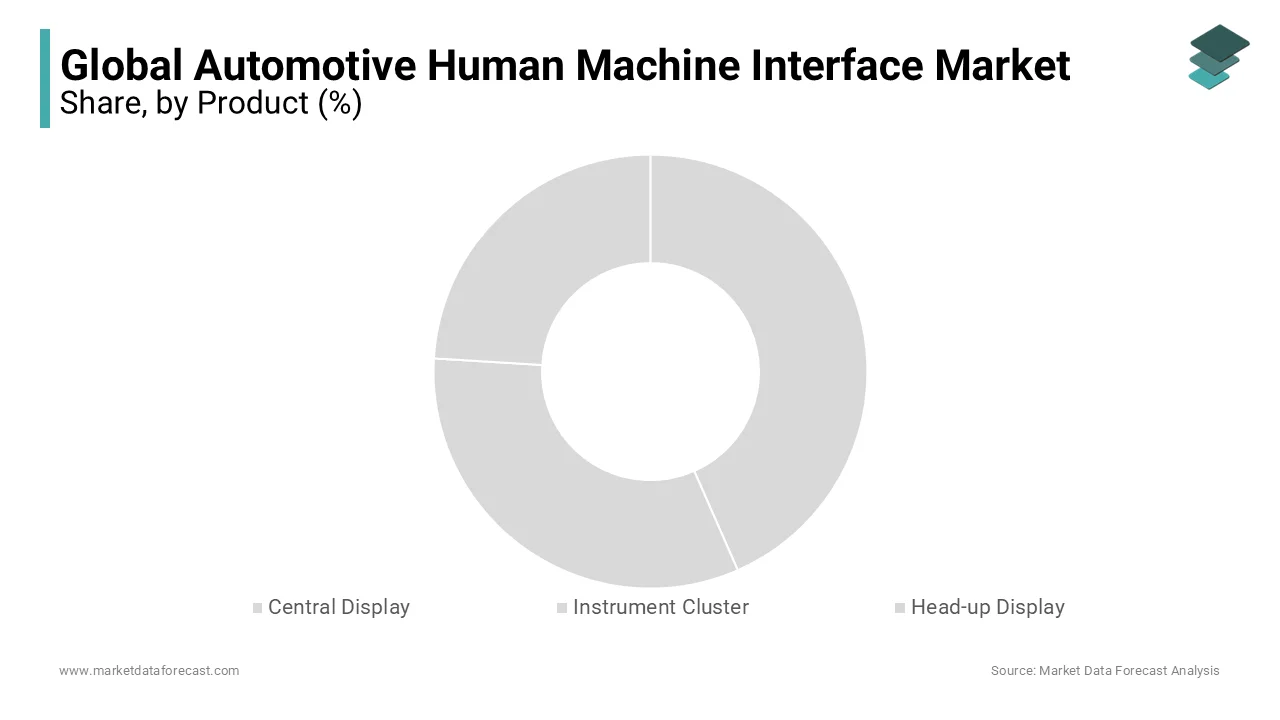Global Automotive Human Machine Interface Market Size, Share, Trends, And Growth Forecasts Report, Segmented By Product Type, Technology Type, Access Type, Vehicle Class Type, and Region (North America, Latin America, Asia Pacific, Europe, Middle East and Africa), Industry Analysis From 2025 to 2033
Global Automotive Human Machine Interface Market Size
The global automotive human-machine interface market was valued at USD 25.13 billion in 2024 and is anticipated to reach USD 27.94 billion in 2025 from USD 65.33 billion by 2033, growing at a CAGR of 11.20% from 2025 to 2033.

CURRENT SCENARIO OF THE GLOBAL AUTOMOTIVE HUMAN MACHINE INTERFACE MARKET
The automotive human machine interface market witnessed rapid advancements in technology in the last few years. Today’s customers have higher expectations for their vehicles than ever before. Cars have evolved into mobile offices, entertainment centers, and essentially high-tech gadgets. Many drivers, especially younger ones, prioritise in-car interface technology over traditional features like leather upholstery or engine power. They seek vehicles that enhance their lifestyles and seamlessly integrate with the mobile apps they rely on. Moreover, features, such as alarm warnings, secure messaging, and enhanced internal communications, should provide a facility with a safety, operational, and production advantage. The new HMIs are expected to reduce operating costs by replacing traditional buttons, lights, and switches, reducing the need for additional cables and display panels, and further improving machine monitoring.
MARKET DRIVERS
The increasing adoption of a better interior for vehicles and the growing consumer concern for safety and security features are the main factors driving the growth of the automotive HMI market.
The importance of user interfaces has become increasingly clear in recent years. Apple products, such as the iPod or iPhone, are iconic examples of how intuitive user interfaces have completely changed the perception of certain types of products. The success of Apple products and other consumer products clearly shows that aesthetic products, graphics, and the standard environment contribute significantly to brand distinctiveness and the consistency of customer experiences. Many industrial companies have reached the same conclusion and are beginning to focus more on the quality of the user interfaces of their products. Higher levels of functions and interactions built into the HMI and growing user needs, such as multi-touch screens and high-quality displays, are expected to drive market growth.
Furthermore, the development of vehicle creation and deals in non-industrial nations in Asia-Pacific is additionally affecting the development of the auto HMI market. The development of the auto HMI portion of the overall industry is straightforwardly subject to the headway of infotainment and correspondence frameworks.
MARKET RESTRAINTS
However, driver distraction is an issue that is expected to restrict the adoption of human-machine interface systems in the automotive industry for the foreseeable future. Strict mechanisms to avoid any unfavorable features in the car, especially when the car is in motion, is a key challenge that car manufacturers and suppliers of automotive man-machine interface systems must address.
REPORT COVERAGE
|
REPORT METRIC |
DETAILS |
|
Market Size Available |
2024 to 2033 |
|
Base Year |
2024 |
|
Forecast Period |
2025 to 2033 |
|
CAGR |
11.20% |
|
Segments Covered |
By Product, Technology, and Region. |
|
Various Analyses Covered |
Global, Regional and Country Level Analysis; Segment-Level Analysis, DROC; PESTLE Analysis; Porter’s Five Forces Analysis; Competitive Landscape; Analyst Overview of Investment Opportunities |
|
Regions Covered |
North America, Europe, APAC, Latin America, Middle East & Africa |
|
Market Leaders Profiled |
ALPS ALPINE CO., LTD., CAPGEMINI ENGINEERING, Clarion, Continental AG, Denso Corporation, EAO AG, Harman International, Luxoft, Marelli Holdings Co., Ltd., Nuance Communications Inc., Panasonic Corporation, Robert Bosch GmbH, Socionext Inc., Tata ELXSI, Valeo SA, Visteon Corporation, Yazaki Corporation, and Others. |
SEGMENTAL ANALYSIS
By Product Insights

On the basis of product type, the infotainment segment dominated the global automotive human-machine interface market in terms of revenue in 2020. Infotainment systems have become a standard feature in most vehicles.
By Technology Insights
The mechanical portion ruled the worldwide car human-machine interface market, as far as income, in 2020. Voice control is assessed to be an extremely worthwhile portion because of the expanding interest in voice acknowledgment-based highlights in vehicles. Moreover, the current COVID-19 pandemic flare-up has expanded the prevalence of contactless HMI frameworks.
REGIONAL ANALYSIS
The Asia Pacific is the biggest region for the automotive human machine interface market, based on demand. However, on the technology front, both Europe and North America are at the top.
Asia Pacific leads the global market for automatic HMIs and is expected to grow further during the forecast period. This can be attributed to the growing demand for these features and components of hardware and software in high-end and luxury vehicles in the APAC region. Like, in India, brands and companies in the Luxury car segment are expanding their footprint in the tire 2 and 3 cities as their demand escalates. The swift rise in the sports cars segment in the region, with Bangalore solely experiencing a surge of 35 per cent, is the main factor behind the strategic decision to extend its reach into South India.
- For instance, lately, Mercedes-Benz India reported that it has made an investment of 150 crore rupees to modernize and improve 25 of its stores into luxury lounges.
North America is a significant automotive human machine interface market holding a major share. Considering its technological landscape in the automotive industry, the market size of this region is expected to witness greater progress throughout the forecast period. Other key factors which are contributing to the increase in the region’s market share are the highly aware and economically stable population. In addition, Canada and the U.S. are a major market, with robust development prospects.
Europe is also one of the prominent automotive innovations and manufacturing. The region is known for its expertise in design, engineering quality, and consumer experience. The automotive producers are encouraged by granting financial and taxation benefits to utilise modern HMI solutions to meet regulatory standards for vehicle connectivity, emissions, and safety. Further, nations like the United Kingdom, France, and Germany are commanding innovations in the automotive industry, which ultimately expands the market size of this region. Its market share is also rising due to its strict regulations concerning emissions and security, surging the adoption of modern HMI systems.
Latin America is progressing at a consistent pace in the automotive human machine interface market. The region’s market growth rate is mainly driven by Brazil and Mexico. Furthermore, in the coming decade, Brazil will witness a lot of technological developments that will improve the lives of people. Also, in the last few years, it has seen a rapid enhancement in its internet infrastructure due to developments in technology for wireless networks and fiber optics. This current trend is believed to escalate the demand for advanced automotive HMI solutions in their vehicles.
The Middle East and Africa, as of now, is a smaller automotive human machine interface market. However, it is projected to grow over the forecast period. This can be credited to increasing consumer demand for more sophisticated automated features and disposable income.
KEY MARKET PLAYERS
ALPS ALPINE CO., LTD., CAPGEMINI ENGINEERING, Clarion, Continental AG, Denso Corporation, EAO AG, Harman International, Luxoft, Marelli Holdings Co., Ltd., Nuance Communications Inc., Panasonic Corporation, Robert Bosch GmbH, Socionext Inc., Tata ELXSI, Valeo SA, Visteon Corporation, Yazaki Corporation are playing a dominant role in the global automotive human interface market.
RECENT HAPPENINGS IN THIS MARKET
- Clarion Co., Ltd. aims to overcome the challenges driving automation and the connected car pose to automotive HMIs by providing new onboard information systems that offer transparent access to information.
- The Horizon2020 MEDIATOR project aims to develop an intelligent support system for road transport that mediates between automatic and human driving, allowing a safe and real-time change between a person and a machine by monitoring and information on weighing and the status of vehicle automation. Mediator systems will customize smart technology based on the capabilities of each driver and the strengths of the automated system.
- TOKAI RIKA Co., Ltd. and Alps Alpine Co., Ltd. together fostered a capacitive screen board as an interface item. New age human-machine (HMI) that works with protected and agreeable versatility by permitting instinctive control of an assortment of data through capacities, for example, vehicle route frameworks and radiator control switches. The organizations will keep on fostering the item and present recommendations to likely clients for its execution in 2024.
- Alps Alpine Co., Ltd. (Tokyo: 6770; President and CEO: Toshihiro Kuriyama) has consented to another permit arrangement with Immersion Corporation (San Francisco, California, USA), a main designer and licensor of innovation from material input. The understanding covers Alps Alpine's utilization of Immersion's Active Sensing ™ # innovation and expands on a longstanding coordinated effort to reinforce auto human-machine interface (HMI) exercises.
MARKET SEGMENTATION
This research report on the global automotive human-machine interface market has been segmented & sub-segmented based on the product type, type, and region.
By Product
- Central Display
- Instrument Cluster
- Head-up Display
- Others
By Technology
- Visual Interface
- Acoustic
- Mechanical
- Others
By Region
- North America
- Europe
- Asia Pacific
- Latin America
- Middle East and Africa
Frequently Asked Questions
What is the current market size of the global automotive human machine interface market ?
The size of the global automotive human machine interface market is at USD 27.94 billion in 2025
What Is The Future Growth Of Global Automotive Human Machine Interface Market ?
The global automotive human-machine interface market is predicted to grow to USD 65.33 billion by 2033
What Are The Dominating Factors Of the Global Automotive Human Machine Interface Market ?
ALPS ALPINE CO., LTD., CAPGEMINI ENGINEERING, Clarion, Continental AG, Denso Corporation, EAO AG, Harman International, Luxoft, Marelli Holdings Co., Ltd., Nuance Communications Inc., Panasonic Corporation, Robert Bosch GmbH, Socionext Inc., Tata ELXSI, Valeo SA, Visteon Corporation, Yazaki Corporation, They are playing a dominant role in the global automotive human interface market.
Access the study in MULTIPLE FORMATS
Purchase options starting from
$ 2500
Didn’t find what you’re looking for?
TALK TO OUR ANALYST TEAM
Need something within your budget?
NO WORRIES! WE GOT YOU COVERED!
Call us on: +1 888 702 9696 (U.S Toll Free)
Write to us: sales@marketdataforecast.com